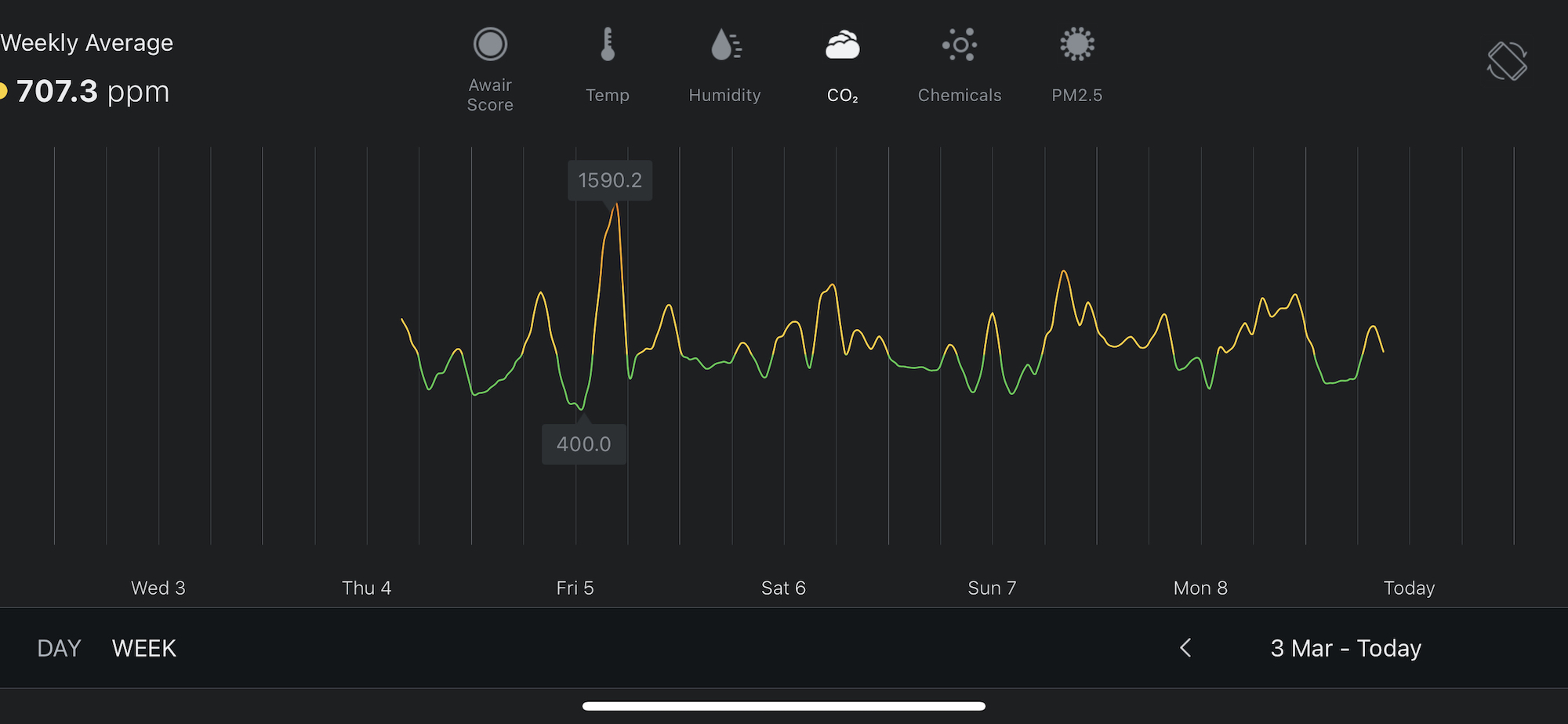A review of the Awair Element indoor air quality monitor
March 8, 2021 in Hardware

Awair Element, banana for scale
The Awair Element is a five-dimensional air quality monitor with data logging, a pleasant design, and convenient integrations. It costs $149. I liked that it was very easy to set up, and then it simply works, sending you reminders to open a window or humidify more.
Core features
The Awair Element measures 5 values over time:
- Temperature – funny that it defines a fixed “ideal” zone for temperature because everybody has their own opinion.
- Humidity – if it’s low (dry), skin and eyes go itchy, and dust goes up; if it’s high (wet), your house feels like a sauna, and eventually, you get mold.
- CO² – more CO² in the air makes you literally less smart. Of course, no one will suffocate in their house, but you can get to IQ-affecting levels in a couple of hours in a closed room.
- VOCs – vaporous pollutants like solvents, household chemicals, and farts.
- PM2.5 – solid pollutants – the finest (and the worst) kind – indoor and outdoor dust, cooking fumes.
In my household testing, all of these show reasonable values and change with inputs. So it gets a “good enough” seal of approval. In my opinion, you don’t need lab-level precise values — the point of an air quality monitor is to help you make adjustments, not to do science. What’s far more valuable is the convenience and integrations.
I like a lot that there is a fan inside the monitor, so it actively circulates air. That’s why I am more confident that the monitor reflects broader room conditions.
That said, it takes around 5 minutes for the Awair to show actual values if you carry it from room to room.
You get not only momentary values but a historical log — accessible through the app and APIs. This is useful to understand how your atmosphere changes over time and what affects it.
Build

Left: backside, displaying USB-C port. Right: PM2.5 warning in the kitchen after some heavy frying.
-
The Awair Element has a USB-C port for power. This is great! You can plug it into any USB power source — not only a wall wart but your computer, your car, a power bank. I haven’t tested it outside yet, but no reason it wouldn’t work in a car or at your favorite outside working space (Wi-Fi provided.) And you can definitely carry it from room to room — the historical charts are not designed for this, but that’s the only issue.
-
It has a nice white dot-matrix display. The display can auto-dim. Also — crucial for the bedroom — you can configure it to turn off under low light.
-
The main display mode shows a status bar chart. It’s good for getting acquainted with your air. Then you can switch it to show a value that you’re most interested (CO²? humidity?) or the time. Or, turn the display off completely, and use the app and integrations.
-
There’s a convenient and responsive button to cycle through display modes. Any other settings — like brightness — are controlled from the app. Also, there is no power button — the device works as long as it is plugged in.
-
Sadly, there is no wall-mounting option. Not only are there no mounting holes, but the power socket points directly backward. (Besides, I don’t know if wall-mounting would affect measurements.)
Connectivity
- It connects over Wi-Fi, but you do primary setup over Bluetooth. A phone with the app is required.
- Once you complete the setup, the device sends data directly to the server. Then you can monitor results from anywhere.
App

Weekly CO² chart
The app is nice and smooth. There’s no jank that you often see with smart device apps.
What’s essential is that you get charts for all the values. Without charts, it’s quite impossible to understand what is going on with the air.
You get push notifications for status changes. You can share access with other accounts. Of course, you can add multiple devices to the same app. Devices (“rooms”) are organized into “homes.”
Integrations
Developer integrations of the Awair are kind of awesome.
For the simplest kind, you have IFTTT. There are triggers for each of the values. You can’t specify a precise threshold, but pick one of the 5 predefined levels.
Then there are APIs. There’s a regular HTTP API, but what’s even better, there’s an API server that works right on the device. So you can build local automation that doesn’t depend on the cloud. Hopefully, even if the company goes out of business, you can continue using that local automation.
There are other integrations, with smart assistants to announce values, and with a couple of thermostat models.
And, you can export the log as a CSV, straight from the app. The CSV contains precise values with a 5-minute resolution.
Conclusion
Who would need an air quality monitor? Well, most everyone who lives indoors. Because, as studies show, more CO² in the room makes thinking harder. So you need to ventilate regularly. But how often? And should you do it now? An air quality monitor makes you aware of what you are breathing, and if you’re industrious enough, it can even help you improve it — automatically.


